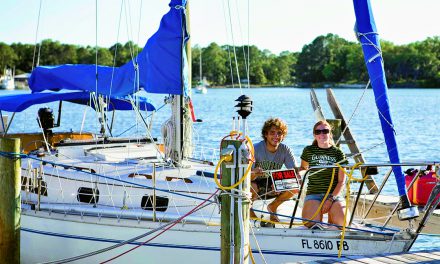This a followup to Durkee Richards’ article “A Boat Explodes” in the July 2012 issue.
When the boat next door explodes . . .
Catherine Bilyard described Invictus, their Shannon 38 ketch, as “a boat with soul and history.” The soul comes from her seakindly motion and the grace with which she handled heavy weather in the Strait of Juan de Fuca. As to her history, hull #12 was first owned by Marshell and Fran Damerell. They christened her Invictus and circumnavigated between 1980 and 1983. The Bilyards were the third owners. They renamed her Invictus and invited Fran and Marshell to the christening ceremony.
Invictus was moored immediately alongside Escale in the John Wayne Marina in Port Angeles, Washington, when Escale exploded last January. Amazingly, Invictus appeared to have suffered no structural damage although the starboard side of the hull was pockmarked by shrapnel, the dodger was destroyed, and the running rigging cut up. The initial assessment was that repairs would likely top $15,000 but Invictus would sail again.
The Bilyards were ultimately cashed out by their insurance company when the final tally for repair costs reached the agreed value stated in their yacht policy.
I am writing this summary to explain the course of events and as a caution to other boat owners that the full extent of damage from such events may be considerably worse than it at first appears.
Ironically, Gordon Bilyard met Keith Bryant, the skipper of Escale, for the first time the afternoon of the explosion. That day, Gordon was tending to the brightwork in the cockpit of his ketch. If the timing of events had been different, he might have been directly in the path of the flying debris when Escale exploded.
Claim procedure
If you have never had to place a claim for damage caused by someone else, here is how the process usually proceeds. First, the owners of damaged boats contact their own insurance carriers. Each insurance company will send the surveyor of its choosing to assess the damage. (If the damage is extensive, it may be prudent for a boat owner to engage separately the services of a surveyor who would then represent only the owner’s interests.) The owner of the damaged boat and the insurance company decide upon a course of action: repair the boat or total it. The insurance company then seeks to recover its costs from the party legally responsible for the damage.
This process works well if the damage is greater than the deductible stated in the policy.
For claims less than the deductible, however, the owner of the damaged boat will be on his own to proceed against the liable party and that individual’s insurance carrier.
Escalating estimates
During the first survey of Invictus, the surveyor looked for structural damage, particularly along the hull-to-deck joint, and found none. No assessment of the standing rigging was done at this time. Shortly afterward, the national office for the Bilyards’ insurance carrier called to warn of possible hull-to-deck joint failures. Field reports on boats that had experienced similar shocks due to explosion revealed failures of this critical joint after a year or two of use, even though the boats had initially appeared sound. A second survey was done and, like the first, found no evidence of structural damage.
The Bilyards motored Invictus to nearby Anacortes, Washington. There, they got four estimates for the necessary gelcoat repair. The yard they selected for repairs found that some of the interior joinery had been damaged when the hull flexed with the shock of the explosion. When they removed the damaged joinery, they were better able to inspect the critical areas of the hull. This led to a third survey that also found the hull-to-deck joint along with the main bulkhead tabbing to the hull and deck to be intact.
A rigging assessment done at this time found that several shrouds on the starboard side had been damaged by flying debris and the masts and booms were pockmarked. The mizzenmast step had also been cracked when the boat flexed under the impact of the blast.
The spars on Invictus are anodized aluminum. The yard suggested that the most cost-effective way to proceed would be to prime and fair the spars and paint them with linear polyurethane. This work, along with the other issues, brought the total estimate for repairs up to $60,000.
The insurance company pointed out that the contract language in this case required them to return the boat to the condition it was in before the explosion. Painting the anodized aluminum mast was not consistent with this obligation. Therefore, the yard priced a replacement set of masts and booms. The resulting total was now essentially at the agreed value on the boat: $125,000. Hence, the insurance company decided to “cash out” the Bilyards: the company would pay the Bilyards the agreed value stated in the yacht policy and take Invictus for her salvage value.
Gordon and Catherine now had a choice. They could take the cash settlement and begin a search for another boat or they could pay the insurance company the salvage value, keep Invictus, and use their cash settlement to complete repairs. They eventually decided on the former path. This was due, in part, to concerns that it would be more difficult and expensive to fully insure a boat that had been totaled by an insurance company.
Postscript
Invictus will sail again. The yard bought her for her salvage value. The yard managers often buy project boats as investments. These boats give them a way to keep staff busy during the winter months. The brother of the yard owner wants to buy the boat.
Did the insurance settlement make the Bilyards whole again? Not really. As most of us realize, once we include the time and dollars spent on upgrading our boats, as well as the purchase costs (sales taxes, travel, and survey costs), we have considerably more invested in our boats than the agreed value stated in the insurance policy. Furthermore, there will be a similar investment of time and money made in their next boat.
Final note: Keith Bryant may have died from the injuries he sustained during the explosion, but his liabilities to other boat owners live on. They are the responsibility of his insurance carrier. The Bilyards say that, so far, Keith’s insurance company has denied all claims. This seems to be an indefensible position. However, it does delay the payment of large sums until the opposing companies settle. It will also shut out most small claims, those that are less than the owner’s deductible amounts, since most such owners will not find it worth the time and expense to litigate.





